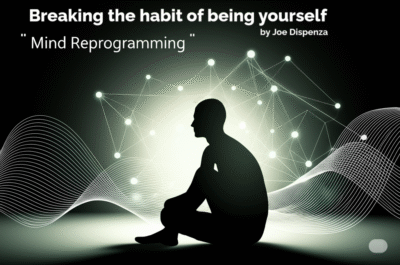Introduction
Have you ever wondered how you could completely reshape your inner world and behavior? Mind Reprogramming offers a bold promise: to free you from limiting patterns and launch you into a life you truly desire. In this review, we’ll explore how “Breaking the Habit of Being Yourself” guides you through a scientific and practical journey, starting from broad concepts and narrowing down to actionable steps. Along the way, you’ll discover real-world examples, clear explanations, and the most impactful takeaways that you can apply today.
Table of contents
- Introduction
- 1. Overview of Mind Reprogramming : (Breaking the Habit of Being Yourself)
- 1.2 From Theory to Focus
- 2. Core Concepts Behind Mind Reprogramming
- 3. Practical Steps to Change Your Inner Blueprint from: Breaking the Habit of Being Yourself
- 4. Examples That Illustrate Real-Life Impact
- 5. Benefits and Long-Term Effects from: Breaking the Habit of Being Yourself
- Conclusion
- references
1. Overview of Mind Reprogramming: (Breaking the Habit of Being Yourself)
In this opening section, we present a bird’s-eye view of the ”Breaking the Habit of Being Yourself” premise and framework, then zoom in on its unique approach.
1.1 General Framework
“Breaking the Habit of Being Yourself” unites neuroscience, quantum theory, and structured awareness exercises. Therefore, it invites you to recognize how your thoughts shape your reality. The author argues that you live under unintentional autopilot, driven by neural connections formed over years. Consequently, the first step involves observing your current thought-emotion loops without judgment.
1.2 From Theory to Focus
After introducing core scientific principles, the book ” Breaking the Habit of Being Yourself ” narrows down to Mind Reprogramming techniques. You learn how to disengage from the old mental software that generates stress, self-doubt, and repetitive behaviors. In short, the text transitions from abstract ideas to clear methods for identifying and replacing limiting patterns.
2. Core Concepts Behind Mind Reprogramming
To transform your mind, the author of ” Breaking the Habit of Being Yourself ” presents three pillars: neural change, energetic fields, and focused awareness exercises.
2.1 Neural Change and Plasticity
Brain architecture never remains static. Research from 2011 at University College London showed that professional taxi drivers expanded their hippocampus region by up to 15% through spatial navigation practice. Similarly, when you repeat new ways of thinking, you form fresh pathways and weaken old ones.
2.2 Quantum Field Interplay
Although you may not delve into complex equations, the concept helps you understand that everything, including thoughts, exists as patterns of energy. Grasping this idea empowers you to see your mind as a dynamic field rather than a fixed entity.
2.3 Focused Awareness Exercises
Instead of traditional contemplative rituals, the book teaches you to use precise attention shifts. For example, you learn how to scan bodily sensations, label emotions, and then guide your attention toward a desired state—such as calm confidence. By practicing these exercises for 20 minutes daily, you train your brain to adopt new baseline responses.
3. Practical Steps to Change Your Inner Blueprint from: Breaking the Habit of Being Yourself
This section answers “How do I apply these insights?” with concrete, step-by-step guidance.
3.1 Step 1: Conscious Observation
- Notice recurring thoughts or emotional reactions when you face stress.Record them briefly in a notebook, noting triggers and physical sensations.
3.2 Step 2: Defining Your New Self
- Visualize specific qualities you want—such as resilience or creativity.Write a clear statement in the present tense (e.g., “I remain calm under pressure”).
3.3 Step 3: Focused Awareness Practice
- Allocate a quiet 15- to 20-minute session each morning.Scan your body from head to toe, acknowledging tension.Engage with your written statement, feeling its reality as already true.
3.4 Step 4: Daily Integration
Pause at regular intervals to recall your new statement.
Act in alignment: if you feel your old reaction, gently redirect your thoughts toward your chosen state.
4. Examples That Illustrate Real-Life Impact
Concrete stories make the theory tangible. Here are two anonymized cases inspired by themes in the book:
4.1 From Anxiety to Confidence
A software developer struggled with stage fright during presentations. After two weeks of focused awareness sessions, she noticed her heartbeat settled within the first 90 seconds of a talk. Over three months, her self-rating for public speaking rose from 40% confidence to 85%, fueling a promotion opportunity.
4.2 Overcoming Self-Sabotage
An entrepreneur repeatedly abandoned projects at the first sign of difficulty. By tracking negative inner dialogues—“I can’t do this”—he replaced them with “I solve challenges creatively.” Within eight weeks, he completed a product launch that had stalled for half a year.
5. Benefits and Long-Term Effects from: Breaking the Habit of Being Yourself
Finally, let’s highlight the most transformative advantages you can expect when you apply Mind Reprogramming consistently.
5.1 Enhanced Emotional Resilience
By reshaping your habitual responses, you endure setbacks with greater calm. Studies show that individuals who practice awareness exercises reduce stress-related cortisol levels by up to 25% within two months.
5.2 Clearer Decision-Making
When you release old thought patterns, you open up mental bandwidth for creative solutions. You begin to spot opportunities rather than fixate on obstacles.
5.3 Sustainable Habit Change
Unlike quick fixes, this approach rewires your brain at a foundational level. You no longer rely on sheer willpower; instead, your new neural pathways guide you effortlessly toward your goals.
Conclusion
Are you ready to embark on the path of Mind Reprogramming? “Breaking the Habit of Being Yourself” equips you with both a scientific understanding and practical toolkit to rewrite your inner story. By observing your present state, defining your ideal self, and engaging in structured awareness exercises, you can transform thought patterns that once held you back. The journey demands consistency, yet the rewards—emotional freedom, clearer thinking, and lasting personal growth—make every effort worthwhile.
references
- Maguire EA, Gadian DG, Johnsrude IS et al. 2000. Navigation-related structural change in the hippocampi of taxi drivers. Proceedings of the National Academy of Sciences. https://www.pnas.org/content/97/8/4398
- Pascoe MC, Bauer IE. 2015. A systematic review of cortisol reactivity to acute stress in mindfulness-based interventions. Neuropsychobiology. https://www.karger.com/Article/FullText/442646
























